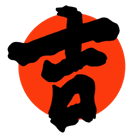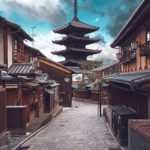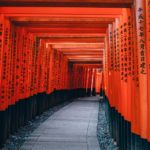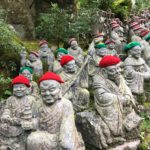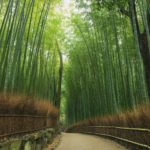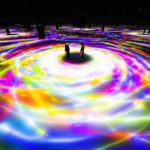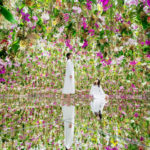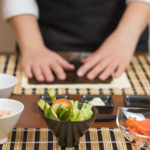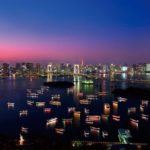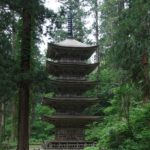Day 1 (MON 10/17): Tokyo
Since your flight will be landing late at night. We will be leaving this arrival day unplanned.
Day 2 (TUE 10/18): Tokyo
Since this trip is very much centered around culinary, and cultural experiences, I wanted to start your trip off with a nice meal, and a short lesson on eating etiquette in Japan at a two-star Michelin restaurant. In Japan there are ways that you should accept a meal when it is being handed to you. There are also special phrases that are used when starting a meal, and when you are finished with a meal. There will be many places to eat on this journey, so we thought that it would be prudent of us to prepare you for this journey by equipping you with the right knowledge.
We like to orientate all of our clients when they arrive in Japan. We typically do this by sending them somewhere that gives them an idea of just how massive Tokyo is. We would like to send you on a very short helicopter tour around the major sites of Tokyo for this purpose.
Activities:
- Japanese culinary etiquette lesson at Michelin-star restaurant
- Short helicopter tour of Tokyo at dusk
Culinary Experiences / Restaurant options:
- see above
Planner's Notes: We don't want to "over-plan" for your first day. Thus we have left the evening open for you to rest and recover from your previous travels.
Day 3 (WED 10/19): Tokyo
Today, activity-wise, is a very simple day. It is a day that shows you both the ancient, and modern sides of Tokyo. Starting with the older side of Tokyo, the day will begin in Asakusa where you will visit Sensouji Temple with a guide who can give you the history of the site as it is one of the most important temples in Tokyo. On the temple grounds there is also a shrine. The word "temple" typically refers to a Buddhist structure in Japan, whereas the word "shrine" will typically refer to a Shinto structure. Your guide can further elaborate on the differences between the two while you travel through the area. Asakusa is also known for its food. I would like to craft a small food tour of the area after visiting the temple. We could put something together that sort of encapsulates some of Japan's more traditional street foods, with a few options that include more modern takes on traditional foods. Some of the options include:
- kibi-dango
- age-manju
- yakkitori
- maccha gelato (there is a place that is famous for its extremely strong maccha here)
- yaki-dango
- nikuman
- taiyaki
That will conclude the first 'traditional' half of the day. Although we do want to have a private car for you guys during your travels, I think that getting to the next destination using some form of public transportation is an experience in-and-of itself. The destination is the Toyosu and Odaiba areas, which are islands made of reclaimed land in the center of Tokyo Bay. As the first half of your day is spent in Asakusa, it is really easy to catch a ferry from Asakusa port to the island, and will give you guys a view of Tokyo during the day from the canals and port areas that otherwise wouldn't be seen. The other option is one of the only unmanned, automated monorail systems in Japan that would also give you a very good view of different neighborhoods in the city. Private car is also an option though. The destination is a modern art installation that is very difficult to describe. It is called 'Planets' and it is the work of TeamLab. It is a series of rooms that each have a completely different experience in each of them. Some are more tactile, some are more visual, but each is mesmerizing. As it is somewhat difficult to describe, I've put a link next to the activity to give you an idea of what it is like. Odaiba and Toyosu are also home to all of the concept halls for most of the major corporations in Japan, and home of what is known as the "Future Museum" that houses lots of other concept tech, and serves as an education center. Currently, I will only place the TeamLab Planets as a destination, but will try to leave space for other activities there should you wish to stay longer.
Activities:
- Visit to Sensouji Temple (guided)
- Short traditional street foods tour (guided)
- Ferry to Toyosu
- TeamLab Planets
- https://www.youtube.com/watch?v=Hg5nW3_6F6s
- The "Future Museum" (optional)
Culinary Experiences / Restaurant options:
- Locale (first choice)
- Locale is a relatively new restaurant in the Meguro ward of Tokyo. Not super-famous, but extremely unique. It was started by a Californian chef, with a strong focus on farm-to-table fresh ingredients and working closely with farmers in Japan. Very small, and intimate.
- https://www.locale.tokyo/
- Faro
- An Italian restaurant with a Japanese head chef that really blends the line between art and food. The head chef has been awarded two Michelin stars for work at previous establishments.
- https://faro.shiseido.co.jp/en/menu/
Planner's Notes: For both of these restaurant recommendations, the focus was on restaurants that have a passion for working with local farmers to bring fresh ingredients to the table. They are both excellent. Locale is a much more intimate experience though, as whenever I go, the chef always takes time to speak to us, and I can feel how passionate she is about her "home". Another reason I've placed these two restaurants as options for this day, is because they aren't open earlier in the week.
Day 4 (THU 10/20): Kyoto
I would like to move you guys to Kyoto today, as the matsuri festival will be taking place here soon, and I don't want to rush you guys there for when it happens, so I would like to move towards the Kansai region on this day, however the Tokyo travels will resume towards the end of your trip.
The bullet train from Tokyo to Kyoto is about 2+ hours, so I would like to get you guys there in time for brunch at a cafe that only serves brunch (refer to the notes below). After that, I'd like plan visits to three of Kyoto's most iconic sites with a guide. Kiyomizudera, Fushimi-Inari, and Sanjusangendo. I'm placing these locations here on the first day in Kyoto as I think that these are some of the most important temple and shrine visits in the city. There are literally thousands of temples and shrines in the area, and it's difficult to know which ones to visit. I think that these are some of the best to visit in the city for both their history and their beauty. I'm also quite aware that a lot of people get "temple'd" out at some point, and I don't want to overwhelm you with visiting too many in one visit. Dinner suggestions mentioned in the notes below.
Activities:
- Kiyomizudera visit (guided)
- Fushimi-Inari visit (guided)
- Sanjusangendo visit (guided)
Culinary Experiences / Restaurant options:
- Brunch at Kishin
- This is a small breakfast/brunch-only establishment that focuses on hearty meals in Kyoto. This is also (possibly) the location that the chef you are meeting with will use to teach you how to cook washoku meal on Day 5.
- https://www.kishin.world/
- Dinner at Kibunesou
- Banzai is Kyoto's version of a kaiseki meal. This restaurant is out in nature. The outdoor seats are tatami mats set on top of a river. The menu here changes with each season. It is one of the ideal locations for what I would consider to be a traditional Kyoto-style meal.
- https://www.kibunesou.com/
Planner's Notes: I like to plan trips that are more centered around actual experiences, rather than things that you simply 'look at'. Thus I have minimized the number of temples and shrines that you are visiting here in Kyoto in favor of the festivals, swordmaking, and cooking lesson that is planned. There are other locations on this trip where you will visit a few more shrines and temples, however. If you wish to add more to this itinerary, please do let me know. Also, I highly suggest having a guide for the temple and shrine visits of this day.
Day 5 (FRI 10/21): Kyoto
For each region that you visit, I would like to plan a culinary experience. For Tokyo there was the etiquette lesson, paired with the kaiseki lunch. For Kyoto, I'd like to pair you with a chef who will teach you all of the basics of washoku (Japanese cuisine). They'll start with the selection of ingredients at Kyoto's largest market, Nishiki and possibly a visit to one of the local farms to pick vegetables from. From there they will teach you how to prepare the ingredients, and prepare a meal. The Japanese chef that we have in mind is from a family of chefs. His father started a Michelin-starred restaurant, and he continued his father's legacy by starting one in New York City. It is absolutely a rare opportunity.
Planner's Notes: This would be an all-day experience. I am thus, for now, leaving the rest of this day open for you guys to have free time to visit a bar, sing karaoke, or whatever moves you. I can make recommendations and or reservations if necessary, of course.
Day 6 (SAT 10/22): Kurama
Today is all about the element of fire, with the culmination of the day being a fire matsuri in the norther region of Kyoto. I'd like to start the day off early in Kameoka where you guys can forge your very own small katana with a swordsmith who will guide you through the process using traditional techniques. This is the only remaining swordsmith forge in the Kyoto region. As I've heard from both Monique and Lilia that Mr. Conti is a fan of food, and cooking, we could arrange for you to make a knife instead. Whatever you make will be placed in a nice wooden box (for safety).
In the evening I would like to arrange for you both to see the amazing Kurama Hi Matsuri. A 'matsuri' is typically translated as a "festival", but it's a bit more than that. The events are all very specific to each region or location that they are held in, and are steeped in historical significance. The Kurama matsuri is over a thousand years old and was birthed in war event. A regional war made it necessary to move a shrine to this area, and when doing so, people lit torches in order to guide the spirits of that shrine to this region. The streets of Kurama will be lit with bonfires and torches starting around 6PM. Some of them are smaller, and you may even witness small children carrying them through the streets, and some are much, much, much larger (some weigh up to 200kg). The people in the area take this opportunity to show off some of their family heirlooms as well, so you may very well see some armor, and katana being displayed in windows of the homes in the area. The finale of the festival is when a group of men carry a mikoshi (basically a palanquin made for a god) up a steep set of stairs to the shrine. It is, in my opinion, the highlight of this trip.
Activities:
- Crafting either a knife, or small katana (kogatana) with a swordsmith
- Kurama Hi Matsuri
- Jidai Matsuri (optional)
Culinary Experiences / Restaurant options:
- Menbaka Fire Ramen
- This is a traditional ramen spot that includes a bit of theatrics with their meal. When serving the ramen to his guests, the chef likes to serve it with fire. The ramen is great, and the staff is known for their friendliness and good nature.
- http://fireramen.com/menbaka/index.html
Planner's Notes: There is another matsuri event that is happening on this day as well. It is called Jidai Matsuri. It is a parade, more than a matsuri festival, but it is a spectacular view. It starts at the Imperial Palace, and ends at Heian Shrine. The parade celebrates the day that Kyoto was founded as a city. People in the parade wear period clothes, and many important figures make an appearance in the parade (like the governor of Kyoto). My hesitation with adding this is simply based on whether there will be time to fully enjoy it before having to head out to Kurama. Logistically, the swordmaking experience should end around 1PM (starts at 9AM), from there I wanted to take you guys to the menbaka ramen restaurant for lunch. I think that after lunch, the parade will be mostly finished. Alternatively, we could schedule the sword-making lesson on the 20th when you arrive in Kyoto for 1PM and dedicate this day entirely to both matsuri events, and lunch at menbaka. The Jidai Matsuri event is most certainly worth it, as the parade is amazing and it also gives you an idea of what a procession was like during different periods in Japan's history.
Day 7 (SUN 10/23): Kyoto
I want to leave this day relatively unplanned, and keep the pace a bit slower as you will be heading out to other destinations outside of the two major cities from here on out. This will be used as a rest day, however I would still like to plan a traditional tea ceremony here in Kyoto, as it is the birthplace of this ancient art form, and a lunch and/or dinner reservation. The tea ceremony is best had where the art was originally developed, Daitokuji Temple. There you can learn of all of the significance of its rituals, and experience a short tea ceremony there where it began.
Activities:
- Traditional tea ceremony at Daitokuji Temple complex
Culinary Experiences / Restaurant options:
- Lunch at Isshisoden Nakamura (first choice)
- This is the only restaurant that I'm aware of that has three Michelin stars in Kyoto. It is extremely unassuming though. It's such a simple place. Nothing is over-the-top, nor flashy. It's just really good food, and it is famous for its white miso zoni. The current chef is the sixth generation to run the restaurant.
- http://www.kyoryori-nakamura.com/index.html
- Lunch at Kichi Kichi Omurice
- As a second choice, I would like to suggest a small restaurant in the Pontocho district that is famous for its 'omurice' dish. "Omurice" is a mixture of the words 'omelette' and 'rice', and the dish is... a rice dish that is topped with an omelette. It's a pretty famous dish around the country, but the chef here at Kichi Kichi has made it his signature dish.
- https://kichikichi.com/
- Dinner at Jugyuan
- https://jugyuan.jp/
Planner's Notes: There are plenty of really nice restaurants in the Pontocho area of Kyoto. The street is lined with hundreds of places, and although I have made a dinner suggestion on this day, I don't want to "over-plan" your itinerary and thus prevent you from self-exploration and finding places on the street that might interest you.
Day 8 (MON 10/24): Osaka
(Day unplanned per client request)
Visit to Teshima Island and the Teshima Art MuseumVisit to Naoshima Island, and the art exhibits on display thereVisit to Shinshoji Zen Museum (mostly for visiting the Hyotei building on its grounds, but if you are interested in trying zen meditation while here, we can arrange for that experience as well)
Shojin-ryouri experience at the Zen Museumhttps://szmg.jp/
Day 9 (TUE 10/25): Osaka
(Day unplanned per client request)
The voyage includes breakfast, lunch and dinner, and there is a washoku restaurant, a sushi bar, a youshoku ('western' cuisine) restaurant, a bar and a lounge all on the ship for your enjoyment. The meals are sometimes impromptu. There are smaller ships which will deliver freshly caught seafood from the Inland Sea while you are traveling it, and a chef will then prepare that catch immediately in front of you.
Day 10 (WED 10/26): Osaka
(Day unplanned per client request)
Visit one of the Sekizen IslandsShort hike of Mt. Shiude, which offers a stunning view of the islands of SetouchiTrek on Chichibugahama Beach, famed for its beautiful sunsetsVisit Kitagishima, Manabeshima, or Mushima in the Kasaoka Island
Day 11 (THU 10/27): Hiroshima
The 3rd day will end relatively early, as you port at around 11AM. As the ship's crew will have provided you with breakfast, I'd like to move as quickly as possible to Hiroshima, as you won't actually be spending the night there. I would like to show you the highlights of Hiroshima, as the final stop along the Seto Inland Sea route. Having a guide on this day is of major importance. The first stop would be the Peace Memorial Park and Museum, where the A-Bomb Dome is. This, and the Nagasaki Peace Park are sites that all students in Japan are required to visit.
After that, I would like to have your guide take you to Hiroshima Castle, for your first castle visit on this trip, and then head out to Miyajima Island. Miyajima, means "shrine island". The name comes from the fact that the island itself is seen as a sacred place. Thus the name doesn't refer to the number of shrines on the island, but rather the fact that the island itself is seen as a giant Shinto shrine itself. As it was seen as a shrine, giving birth on the island was outlawed, as was burying the dead, and cutting any trees. Deer roam the island freely and can be seen everywhere, sometimes even inside of the port terminal. As they are seen as messengers of the gods in Shintoism, they are left unharmed and are mostly welcomed. There are many reasons I want to send you here. Obviously, the UNESCO World Heritage Site, Itsukushima Shrine is one of them (this is the shrine that has the massive 'floating' torii gate on its shore, but I'm hoping that you can take in some of the spectacular momiji foliage on the island as well. It may be slightly early for them to reach their peak red color, but in my 15 years of living in Japan, I've never been anywhere where the foliage was so dazzling. When I first saw them at their peak, I actually thought that someone must have painted them. There is a small park area near the base of Mt. Misen where they are most brilliant. I'm hoping that you can enjoy them, even if you do not hike the mountain.
After your visit to Miyajima, I would like to prepare a dinner arrangement. Thanks to Hiroshima's geographical location, they can take full advantage of the bounties and climate of the Seto Inland Sea. Meaning, they have access to a lot of fresh ingredients that most landlocked locations do not. The area is known for its delicious citrus fruits, and fresh squid and octopus. I would like to plan for a dinner to experience okonomiyaki. It is this region's most famous dish. it is difficult to describe, but it's kind of like a savory pancake with lots of toppings. It's very good with beer. After a slightly early dinner, it's back off to Hakata to catch the overnight ferry to the Goto Islands. There is an onsen across the street from the ferry terminal for relaxing and bathing before your departure. It is a late departure, and will most likely not board until 10:30PM.
Activities:
- Bullet Train to Hiroshima (around 20 minutes)
- Peace Memorial Park
- Hiroshima Castle
- Miyajima
- Itsukushima Shrine
- Momiji Park
- Daishoin
- Short hike of Mt. Misen or ropeway (optional/time permitting)
- Okonomiyaki dinner
Bullet train to Hakata (around 1 hour)Namiha-no-yuTaiko Maru Ferry
Culinary Experiences / Restaurant options:
- Okonomiyaki at Lopez Okonomiyaki (first choice)
- This is one of the best places to try Okonomiyaki in the city. Also, Lopez has 'horumon' food options that I think is a good treat. Although Hiroshima isn't in Kyushu, it is very close, and the closer you get the more 'motsu' and other hearty organ dishes become a regular thing. So eating here is not only a chance to try good okonomiyaki, but you can try cow's tongue, stomach, and other assortments of organs and innards that are traditionally eaten in the region.
- https://www.facebook.com/profile.php?id=100057664111350 (he doesn't have a website)
- Okonomiyaki at Okonomimura
- There is a building in the heart of Hiroshima's nightlife district that is about 5 stories tall, and the entire place is filled with small teppan restaurants that all do okonomiyaki. "Okonomimura" roughly translates to "the village of okonomiyaki". There are probably about 40+ places there, each with their own take on the dish. It's a very interesting place to visit. This is only my second choice as Mr. Lopez is quite famous for his take on the dish, and he also offers other dishes outside of okonomiyaki that you can try.
- http://www.okonomimura.jp/foreign/english.html
Planner's Notes: This is going to be one of the more travel intense days on the trip. Although the time spent on transport isn't excessive, there is a lot of use of bullet trains on this day. Also, I wanted to note that Kenzo Tange is the designer of the Peace Memorial Park, and many of the structures on the site. He is the same architect that designed the Yoyogi National Gymnasium, which is known as the gym of the 1964 Olympics (I've included a picture of it in the gallery below). Logistically speaking it is somewhat of a tough day to plan. There are no direct flights from Hiroshima to Goto, we'd have to take you all the way to Nagasaki instead (where there is less to see and do), and then book a flight or a ferry, so it would be more travel time, and less actual activities. The current arrangement for this day is not ideal, but it minimizes the travel time and maximizes the time spent enjoying different experiences. Also, most of the food experiences and recommendations up until this point have been more on the refined side. Outside of Tokyo towards the end of the trip most of the places recommended in Goto and Yamagata (with a few exceptions) will be of a much more rustic and homestyle cooking nature. I'd like to note that the Guntu trip is quite popular, if we are unable to book it, I would like to have you guys stay here in Hiroshima at a traditional ryokan on Miyajima, and then add a day to the last few days in Tokyo, so we can get more out of the Kanto region.
Day 12 (FRI 10/28): Hiroshima
(Second night in Hiroshima to be left unplanned per client request)
I think that a good place to start is to visit one of the churches for some historical perspective, some of which stand out harshly in a Japanese setting. Dozaki Church is one of the best to visit, as some of the scrolls that the missionaries brought with them are still intact and on display there. After that, I'd like to arrange lunch at very small ramen shop, Ramen-Bin. It is important to arrive as early as possible here as they typically have a line outside of the door, and the wait can be up 30 minutes. It isn't a fancy place at all, it just has really good food. In fact, that will kind of be the theme of this visit. None of the places are fancy, there isn't much pretense in their presentation either, they rely instead on the freshness of their ingredients and their skill.
The rest of the day will be spent visiting some of Goto's naturally beautiful sites like Takahama Beach, and the onsen near its inactive volcano, Onidake. After that I'd like to make a reservation at what is possibly my favorite restaurant in all of Japan, Katashi. I spent 3 years in Goto. When this restaurant first started, they used to do 'pop-ups' at a local community center on Saturdays to sell their food. It was something that made me look forward to the weekends. Fast-forward a couple of years and they started a very, very small restaurant out in the middle of the woods here on the island. If you didn't know about it, you would never find it. I also don't ever recall seeing a menu there, which has only ever built up my anticipation of what will be served when I visit. This restaurant, along with the ramen shop are my two top suggestions for food here. The region is known for its udon noodles (which are slightly "oilier", and much thinner than other regions), its beef, its wine, and some dishes that are done well here like kamameshi (which is rice cooked in a pot with various vegetables and meats), and kizushi (a type of sushi that is traditionally made in the northern island of Narao where an entire small fish is used as the neta for sushi). It is something that you really don't see often in other regions (I've included a picture of it in the gallery below). I will see if I can convince the proprietor of Katashi to make it for you.
Activities:
- Dozaki Church visit
- Takahama Beach
- Natural Onsen Hot Springs visit
Culinary Experiences / Restaurant options:
- Lunch at Ramen-Bin
- https://farming.shakunage.net/kyusyu/index.html
- Dinner at Kinoguchi Katashi
Planner's Notes: I would like to leave space in the activities for your guide to plan out some activities after meeting you and gauging your priorities for your time spent here. A car is an absolute necessity here in Goto.
Day 13 (SAT 10/29): Yamagata
Reaching Yamagata from Hiroshima is still going to be a journey that requires some time. I think that the best route for this is still to take a plane to Tokyo, and then a bullet train from there. This will be slightly easier to plan as Hiroshima has a lot of regular flights from there to Tokyo. As it is still something that may require time depending on when you depart, and there is a lot of travel involved, I still think leaving this day unplanned is the best option.
I'd like to leave you free to rest, and explore the city of Yamagata after arriving, but I do want to make a reservation at one of the city's up-and-coming French fusion restaurants for dinner. Details below.
Culinary Experiences / Restaurant options:
- Dinner at Pas Mal
- A marriage of French techniques and Japanese ingredients. The restaurant is not only a great place to eat French fusion cuisine, but also a good place to try local sake and wine.
- https://yamagatafrench-pasmal.com/
Day 14 (SUN 10/30): Yamagata
Today is the only day where we would suggest splitting up for two different activities. It isn't necessary to split up, but it may make for a more interesting overall experience when you guys come back together. The two main activities of the day will consist of fishing and cooking with a chef. However since the fishing excursion may last a long time, we thought that it may be prudent to plan another set of activities for Mrs. Conti to enjoy while Mr. Conti is out at sea.
Mr. Conti's itinerary: Wake up early to join the fisherman off of the coast of Yamagata prefecture. All of the necessities will be provided. The fishing excursion typically lasts somewhere between 3-5 hours. Please note that fishing can be arranged either on a boat, or along the rocky coastline, however the likelihood of actually catching fish is higher when done on a boat.
Mrs. Conti's itinerary: While Mr. Conti is out fishing we thought it may be nice to visit some of the smaller wholesale fish markets along the coast. Everything there is caught fresh that day, and you can only gain access to the auctions/market through invitation from a local chef. The goal here is for Mrs. Conti to have a fish of her own as they will both be preparing and cooking their fish with someone later one. While here, Mrs. Conti will learn about what makes a fish a 'good' fish amongst the thousands of fish at the market. After that, time permitting, we would like to arrange a visit to one of Sakata's most famous tea houses for lunch and a geisha performance. It is very rare for a smaller community like this to have geisha, and the fact that the art form exists in this region is due to the wealth that was concentrated in this area during the Edo period. It is a rare treat.
After you have both completed your fish-gathering exercises, you will meet up with a local chef at a sushi or kaiseki restaurant where you will both learn how to prepare the fish from start to finish. This includes descaling and filleting the fish into fillets ready to be cut into fresh sashimi. You can then leave it up to the chef to prepare into various dishes or can make requests for a specific dish. This includes making nigiri and rolled sushi, kaisendon (sushi bowls), grilled dishes, yubiki (scalding fresh sashimi with boiling water, and a variety of other options.
Planner's Notes: We rarely have guests who actually want an experience with a geisha or maiko while visiting Japan. If this is something that you'd prefer that we prioritize, please let us know.
Day 15 (MON 10/31): Tsuruoka
Tsuruoka is the only town in Japan that has been awarded a Creative City of Gastronomy award by UNESCO. One of the main reasons for it being awarded this is the preservation of many heirloom varieties of vegetables over a very long period of time, and the use of said vegetables in the region's shojin-ryouri by the mountain ascetic, yamabushi monks. I would like to dedicate this day to understanding the history of the area, and its food through visiting places that best exemplify the essence of the region.
The first stop is Mt. Haguro. We want the guide to be someone who fully understands the sacredness of the mountains that you will be on. The forest at the base of the mountain is magestic. There are trees there that are over a thousand years old, and there are multiple small shrines dotted throughout the forest. At the beginning of your trek you will see a 600-year old pagoda completely made of wood that stands amongst the towering cedar trees (I've included a picture of this pagoda in your gallery). In the middle of the hike you will have lunch at Saikan, which is a temple that is also a restaurant that was first built in the late 1600's! Here you will try shojin-ryori, the ascetic cuisine of the yamabushi monks that was developed as part of their training which could last for months as they isolated themselves on these mountains for spiritual purposes.
After visiting Mt. Haguro, I would like to send you to a local restaurant that best exemplifies why Tsuruoka is the only place in Japan with the UNESCO designation for its food. The place is called Naa, and it is the very essence of farm-to-table, as they are the farm. After which you will return to Yamagata city proper. At night you will meet up with a your guide for a food and pub crawl of the downtown area. You'll visit three izakaya spots in the city, each of them different from the other to taste and drink at some of the best places in the city.
Activities:
- Short hike of Mt. Haguro and learning the traditions of the yamabushi monks
- Shojin-ryouri meal at a 400+ year old temple
- Nighttime izakaya food/drink crawl
Culinary Experiences / Restaurant options:
- Lunch at Naa
- A true farmer's restaurant, and the essence of why Tsuruoka is the only city in Japan with the City of Creative Gastronomy award.
- https://www.e-naa.com/
- Izakaya nighttime crawl
- There will be three locations on the menu tonight, each completely different. This will be a guided experience of the downtown area of Yamagata.
Planner's Notes: If you guys don't want to have a nighttime izakaya crawl, we could arrange for something else. Yamagata is quite famous for its pottery. There is an experience we could arrange where you make your own pottery, or do a sake taste testing (offering up some of the region's smaller-batch breweries). You could also elect to combine the two experiences.
Day 16 (TUE 11/01): Tokyo
I'd like to leave this day unplanned for the moment. However, I would like to plan a dinner reservation at one of two of the city's more interesting steakhouses.
Culinary Experiences / Restaurant options:
- Sagaya Steakhouse's Moonflower room (first choice)
- Moonflower Sagaya is a special experience prepared by Sagaya Ginza and TeamLab. It is a really beautiful experience. If you look at the website, you'll see that the room is stunningly designed by the same team that produces all of TeamLab's exhibitions. You may assume that it is a gimmick that is used to hide, or make up for a lackluster meal. It is not. The food is very good. The course here is 12 dishes, and it is limited to 8 people per day.
- https://moonflower-sagaya.com/
- Ginza Steakhouse
- This is quite possible one of the simplest steakhouses I've ever visited. The belief here is that if the meat is of a high enough quality, there is no need for anything else. Outside of small side dishes that come with your meal, they really only serve steak here, and the cuts are A5-quality wagyu. The cuts are cooked in front of you on a teppan grill, and are served with salt and pepper... nothing else. The course is all-you-can-eat.
- https://www.ginzano.jp/steak/en/ginza/
Day 17 (WED 11/02): Tokyo
We were initially told that you would be leaving on the 3rd of November, so we have planned up until this day. I want to wait to hear your feedback on this initial itinerary before we plan any firm activities for this day. However, I would like to plan an afternoon tea as a safe meal, as it something that can be had early in the day before a flight.
Culinary Experiences / Restaurant options:
- high tea at Shangri-la
- My personal favorite, but also one that is more 'traditional' than the Imperial Palace. Traditional in the sense that it isn't necessarily something that is unique.
- high tea at the Imperial Hotel
- This offering is more of a representation of the concept of high tea done in a Japanese way. It isn't an imitation of the traditional afternoon tea, but more of an interpretation of the tradition. Far more unique, and very tastefully executed.
Day 18 (THU 10/03): Tokyo
(day left unplanned per client request)
